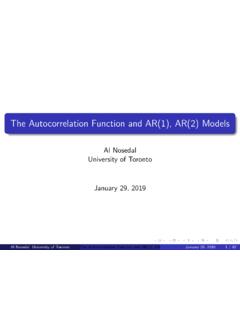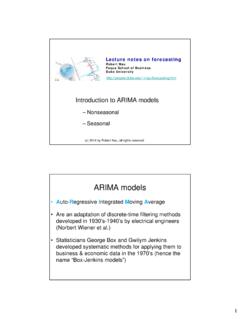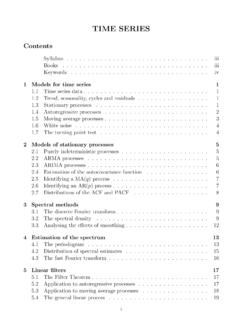Transcription of The Moving Average Models MA(1) and MA(2)
1 The Moving Average Models MA(1) and MA(2) Al NosedalUniversity of TorontoFebruary 5, 2019Al Nosedal University of TorontoThe Moving Average Models MA(1) and MA(2) February 5, 20191 / 47 First-order Moving - Average modelsA first-order Moving - Average process, written as MA(1), has the generalequationxt=wt+bwt 1wherewtis a white-noise series distributed with constant variance Nosedal University of TorontoThe Moving Average Models MA(1) and MA(2) February 5, 20192 / 47 The Autocovariance for MA(1) ModelsWe must compute (k), which is defined as the autocovariance of theprocess at lagk. For simplicity, assume that the mean has been subtractedfrom our data, so thatxthas zero mean. Then (k) =E(xtxt k)Al Nosedal University of TorontoThe Moving Average Models MA(1) and MA(2) February 5, 20193 / 47 The Autocovariance for MA(1) Models (k) =E[(wt+bwt 1)(wt k+bwt k 1)]=E(wtwt k+bwtwt k 1+bwt 1wt k+b2wt 1wt k 1)=E(wtwt k) +E(bwtwt k 1) +E(bwt 1wt k) +E(b2wt 1wt k 1)Al Nosedal University of TorontoThe Moving Average Models MA(1) and MA(2) February 5, 20194 / 47 The Autocovariance for MA(1) ModelsNow setk= 0 and recall that (0) = 2MA, the variance of your series.
2 (0) = 2MA=E(w2t) +bE(wtwt 1) +bE(wt 1wt) +b2E(w2t 1) (0) = 2MA= 2w+ 0 + 0 +b2 2w= (1 +b2) Nosedal University of TorontoThe Moving Average Models MA(1) and MA(2) February 5, 20195 / 47 The Autocovariance for MA(1) ModelsNow setk= 1. (1) =E(wtwt 1) +bE(wtwt 2) +bE(w2t 1wt 1) +b2E(wt 1wt 2) (1) =b Nosedal University of TorontoThe Moving Average Models MA(1) and MA(2) February 5, 20196 / 47 The Autocovariance for MA(1) ModelsFork>1, we will obtain (k) = 0, sinceE[(wt+bwt 1)(wt k+bwt k 1)] will contain only terms whose expectedvalue is For anMA(1), the autocovariance function truncates ( , itis zero) after lag Nosedal University of TorontoThe Moving Average Models MA(1) and MA(2) February 5, 20197 / 47 The Autocorrelation for MA(1) Models (0) = (0) (0)= 1. (1) = (1) (0)=b1 +b2. (k) = 0 for allk> Nosedal University of TorontoThe Moving Average Models MA(1) and MA(2) February 5, 20198 / 47 The Autocovariance for MA(q) ModelsFor the qth-order MA process, we can use a similar derivation to show thatthe autocovariance function, (k), truncates after lag q.
3 Once again (k) =E(xtxt k)Al Nosedal University of TorontoThe Moving Average Models MA(1) and MA(2) February 5, 20199 / 47 The Autocovariance for MA(q) ModelsFork= 0, we obtain (0) = 2MA= (b20+b21+b22+..+b2q) 1, we obtain (1) = (b1b0+b2b1+..+bqbq 1) Nosedal University of TorontoThe Moving Average Models MA(1) and MA(2) February 5, 201910 / 47 The Autocovariance for MA(q) ModelsIn general, we obtain the basic equation (k) = 2wq s=0bsbs Nosedal University of TorontoThe Moving Average Models MA(1) and MA(2) February 5, 201911 / 47 Second-order Moving - Average ModelsConsider the MA(2) process, which is given byxt=wt+b1wt 1+b2wt 2,wherewtis again a white-noise Nosedal University of TorontoThe Moving Average Models MA(1) and MA(2) February 5, 201912 / 47MA(2), Autocovariance functionAt this point, it should be easy to see that (0) = 2MA= (1 +b21+b22) 2w (1) = (b1+b1b2) 2w (2) =b2 2w (k) = 0 fork> Nosedal University of TorontoThe Moving Average Models MA(1) and MA(2) February 5, 201913 / 47MA(2), Autocorrelation function (0) = 1 (1)
4 =b1+b1b21+b21+b22 (2) =b21+b21+b22 (k) = 0 fork> , we see that the autocorrelation function for an MA(2) processtruncates after two Nosedal University of TorontoThe Moving Average Models MA(1) and MA(2) February 5, 201914 / 47MA(1) is an AR( )Suppose that we have an MA(1) modelxt=wt+bwt ,xt 1=wt 1+bwt this equation forwt 1and substitute the result back intoxt=wt+bwt Nosedal University of TorontoThe Moving Average Models MA(1) and MA(2) February 5, 201915 / 47MA(1) is an AR( )This givesxt=wt+b(xt 1 bwt 2)=bxt 1+wt b2wt 2(Now, we repeat the process withwt 2)Al Nosedal University of TorontoThe Moving Average Models MA(1) and MA(2) February 5, 201916 / 47MA(1) is an AR( )xt 2=wt 2+bwt this equation forwt 2and substitute the result back intoxt=bxt 1+wt b2wt 1 b2xt 2+wt+b3wt 3Al Nosedal University of TorontoThe Moving Average Models MA(1) and MA(2) February 5, 201917 / 47MA(1) is an AR( )We can continue indefinitely as long asbsgoes to zero (i.)
5 E.,|b|<1) toobtainxt=wt+bxt 1 b2xt 2+b3xt 3 ..+..This is an AR( ) process, but it only holds under theinvertibilityconditionthat|b|< Nosedal University of TorontoThe Moving Average Models MA(1) and MA(2) February 5, 201918 / 47 More about invertibilityConsider the following first-order MA processes:A:xt=wt+ wt 1B:xt=wt+1 wt 1Al Nosedal University of TorontoThe Moving Average Models MA(1) and MA(2) February 5, 201919 / 47 More about invertibilityIt can easily be shown that these two different processes have exactly thesame autocorrelation function (Right?) (0) = (0) (0)= 1. (1) = (1) (0)= 1 + 2. (k) = 0 for allk> Nosedal University of TorontoThe Moving Average Models MA(1) and MA(2) February 5, 201920 / 47 More about invertibilityIf| |<1, the series (AR( )) for A converges whereas that for B doesnot.
6 Thus if| |<1, model A is said to be invertible whereas model B imposition of the invertibility condition ensures that thereis a unique MA process for a given autocorrelation Nosedal University of TorontoThe Moving Average Models MA(1) and MA(2) February 5, 201921 / 47 Simulated Examples of the MA(1) Modelxt=wt+b1wt 1 There are two cases, positive and negative i)b1= ii)b1= Nosedal University of TorontoThe Moving Average Models MA(1) and MA(2) February 5, 201922 / 47R (9999);# simulating MA(1); < (list(ma = c( )),n = 100, sd=2); ( , ylim=c(-6,8),main="MA(1), b= , n=100");Al Nosedal University of TorontoThe Moving Average Models MA(1) and MA(2) February 5, 201923 / 47 ScatterplotMA(1), b= , n= 6048Al Nosedal University of TorontoThe Moving Average Models MA(1) and MA(2) February 5, 201924 / 47 Autocorrelation Functionacf( );Al Nosedal University of TorontoThe Moving Average Models MA(1) and MA(2) February 5, 201925 / 47 Autocorrelation Function, case i)05101520 Nosedal University of TorontoThe Moving Average Models MA(1) and MA(2) February 5, 201926 / 47R (9999);# simulating MA(1); < (list(ma = c( )),n = 100, sd=2); ( , ylim=c(-6,8),main="MA(1), b= , n=100").
7 Al Nosedal University of TorontoThe Moving Average Models MA(1) and MA(2) February 5, 201927 / 47 ScatterplotMA(1), b= , n= 6048Al Nosedal University of TorontoThe Moving Average Models MA(1) and MA(2) February 5, 201928 / 47 Autocorrelation Function, case ii)acf( );Al Nosedal University of TorontoThe Moving Average Models MA(1) and MA(2) February 5, 201929 / 47 Autocorrelation Function, case ii)05101520 Nosedal University of TorontoThe Moving Average Models MA(1) and MA(2) February 5, 201930 / 47 Simulated Examples of the MA(2) Modelxt=wt+b1wt 1+b2wt i)b1= andb2= ii)b1= andb2= iii)b1= andb2= iv)b1= andb2= Nosedal University of TorontoThe Moving Average Models MA(1) and MA(2) February 5, 201931 / 47R Codeb1<- ;b2<- ; (9999);# simulating MA(2); < (list(ma = c(b1,b2)),n = 100, sd=2); ( , ylim=c(-8,10),main="MA(2), case i)");Al Nosedal University of TorontoThe Moving Average Models MA(1) and MA(2) February 5, 201932 / 47 ScatterplotMA(2), case i) 50510Al Nosedal University of TorontoThe Moving Average Models MA(1) and MA(2) February 5, 201933 / 47 Autocorrelation Function, case i)acf( );Al Nosedal University of TorontoThe Moving Average Models MA(1) and MA(2) February 5, 201934 / 47 Autocorrelation Function,case i)05101520 Nosedal University of TorontoThe Moving Average Models MA(1) and MA(2) February 5, 201935 / 47R Codeb1<- ;b2<- ; (9999);# simulating MA(2); < (list(ma = c(b1,b2)),n = 100, sd=2); ( , ylim=c(-8,10),main="MA(2), case ii)").
8 Al Nosedal University of TorontoThe Moving Average Models MA(1) and MA(2) February 5, 201936 / 47 ScatterplotMA(2), case ii) 50510Al Nosedal University of TorontoThe Moving Average Models MA(1) and MA(2) February 5, 201937 / 47 Autocorrelation Function, case ii)acf( );Al Nosedal University of TorontoThe Moving Average Models MA(1) and MA(2) February 5, 201938 / 47 Autocorrelation Function, case ii)05101520 Nosedal University of TorontoThe Moving Average Models MA(1) and MA(2) February 5, 201939 / 47R Codeb1<- ;b2<- ; (9999);# simulating MA(2); < (list(ma = c(b1,b2)),n = 100, sd=2); ( , ylim=c(-8,10),main="MA(2), case ii)");Al Nosedal University of TorontoThe Moving Average Models MA(1) and MA(2) February 5, 201940 / 47 ScatterplotMA(2), case iii) 50510Al Nosedal University of TorontoThe Moving Average Models MA(1) and MA(2) February 5, 201941 / 47 Autocorrelation Function, case iii)acf( );Al Nosedal University of TorontoThe Moving Average Models MA(1) and MA(2) February 5, 201942 / 47 Autocorrelation Function, case iii)05101520 Nosedal University of TorontoThe Moving Average Models MA(1) and MA(2) February 5, 201943 / 47R Codeb1<- ;b2<- ; (9999);# simulating MA(2); < (list(ma = c(b1,b2)),n = 100, sd=2); ( , ylim=c(-8,10),main="MA(2), case ii)").
9 Al Nosedal University of TorontoThe Moving Average Models MA(1) and MA(2) February 5, 201944 / 47 ScatterplotMA(2), case iv) 50510Al Nosedal University of TorontoThe Moving Average Models MA(1) and MA(2) February 5, 201945 / 47 Autocorrelation Function, case iv)acf( );Al Nosedal University of TorontoThe Moving Average Models MA(1) and MA(2) February 5, 201946 / 47 Autocorrelation Function05101520 Nosedal University of TorontoThe Moving Average Models MA(1) and MA(2) February 5, 201947 / 47










